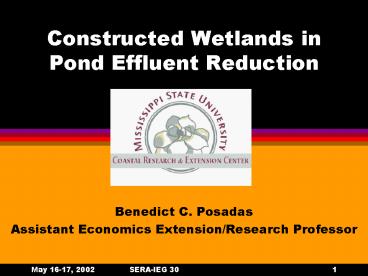Constructed Wetlands in Pond Effluent Reduction - PowerPoint PPT Presentation
1 / 38
Title:
Constructed Wetlands in Pond Effluent Reduction
Description:
Wetlands do appear to significantly reduce the levels of nutrients from catfish pond effluents ... No significant differences in the yield of marketable catfish. ... – PowerPoint PPT presentation
Number of Views:134
Avg rating:3.0/5.0
Title: Constructed Wetlands in Pond Effluent Reduction
1
Constructed Wetlands in Pond Effluent Reduction
- Benedict C. Posadas
- Assistant Economics Extension/Research Professor
2
Participating Agencies
- MSU-Coastal Research and Extension Center,
Biloxi, MS - David Veal, Head
- Mark LaSalle, Estuarine Ecologist
- MSU-Coastal Aquaculture Unit, Gulfport, MS
- Mississippi Power Company, Gulfport, MS
- Delta Pride Catfish, Inc., Indianola, MS
3
Funding Agencies
- U.S. Department of Agriculture
- NRI -1992-94
- NRI- 1995-98
- U.S. Department of Commerce
- SK - 1995-98
4
Objectives
- evaluate effectiveness of constructed marsh
systems toward improving water quality in
aquaculture ponds - determine optimal design and operating criteria
for constructed wetlands - determine the concomitant reductions in risk of
crop loss, incidence of off-flavor, and release
of nutrient-laden effluent into the environment
5
Objectives
- determine the improvement in fish growth and feed
conversion, and - document the costs versus benefits of using this
technology in pond culture
6
Methods
- Pond Size
- 1/4-acre ponds
- 125 ft. long
- 85 ft. wide
- 4 ft. deep
7
Fish Species
- Channel catfish (Ictalurus punctatus)
- Phase II fingerlings (6-7 inch)
8
Wetland Plants
- Duck Potato (Sagittaria lancifolia)
- planted at 1/2- ft. centers
9
Experimental Design
- Control ponds (no marsh, simulated water flow)
- Treatment ponds (marshes of standard size and
flow rate).
10
Wetland Size Variations
- of pond surface area
- small, 15
- standard, 25
- large, 35
11
Flow rate Variations
- Fast
- 13.0 gal/min
- 1-day retention
- Very fast
- 26.0 gal/min
- 1/2-day retention
- Slow
- 3.25gal/min
- 3-day retention
- Standard
- 6.5 gal/min
- 2-day retention
12
Monitoring
- Water Quality in Wetlands (inlet and outlet)
- Weekly salinity, pH, ammonia, nitrite, nitrate,
total phosphorous, total suspended solids
13
Water Quality in Ponds
- Daily (twice per day)
- dissolved oxygen
- temperature
- Weekly
- same as for wetlands
- chlorophyll a
- phaeophytin
14
Statistical Analysis
- Analysis of Variance using General Linear Model
(GLM) - Means compared using SNK multiple range test
- All tests conducted at significance level of 0.05
15
Constructed WetlandsMSU-CAU, 1997
16
Percent changes of inlet to outlet values of
weekly water quality variables in wetlands of
variable sizes, 1997
17
Pond AerationMSU-CAU, 1997
18
Mean values of daily pond water quality
variables in ponds with wetlands of variable
sizes, 1997
19
Mean values of weekly water quality variables in
ponds with wetlands of variable sizes, 1997
20
Mean values of weekly water quality variables in
ponds with wetlands of variable sizes, 1997
21
Dried Matter from Water SamplesMSU-CAU, 1997
- 14P - Sample from Pond 14
- 14I - Sample from Inlet
- 14O - Sample from Outlet
22
Catfish Stocking DensitiesPer Production Acre
- 5,000 3-4 inch in 1994
- 6,000 7-8 inch in 1996
- 8,000 7-8 inch in 1997
23
Catfish Survival Rate
24
Catfish YieldPounds Per Qtr Acre
25
Catfish Off-flavor Scale
26
Wetland Electricity UseKWH Per Week
27
Chemical Costs Per Qtr Acre
28
Net Feed Conversionlbs of feed per lb of fish
gained
29
Daily Aeration Hours
30
Catfish Pond-Wetland Systems
- Six 8-water-acre catfish ponds (CCF)
- Six constructed wetlands built adjacent to
catfish ponds - 15 of pond size or 1.2 acres each
- 25 of pond size or 2.0 acres each
- 35 of pond size or 2.8 acres each
31
Catfish Stocking and Production, 1997
- Stocking rate 8,000 fingerlings per acre
- Stocking size 7-8 inch CCF fingerlings
- Culture period 8 months
- Survival rate 57 percent
- Catfish yield 6,744 pounds per acre
- Net feed conversion ratio 1.02.4
- Catfish off-flavor scale greater than zero
32
Total Investment Requirements
33
Average Investment RequirementsPer Production
Hectare
34
Added costs of constructed wetlands in
recirculating catfish pond production per
production hectare
35
Added costs of constructed wetlands in
recirculating catfish pond production per
kilogram of catfish yield
36
Conclusions
- Wetlands do appear to significantly reduce the
levels of nutrients from catfish pond effluents - Wetlands that are sized to about 25 of pond area
with a 2-day retention time appear to provide
optimal treatment of effluents - No significant differences in the yield of
marketable catfish. - Higher investment requirements and operating
costs.
37
Recommendations
- Testing in commercial farms.
- Use of other economically important culture
species. - Testing other plant species and methods of
creating vegetation.
38
Constructed Wetlands Website
- http//www.msstate.edu/dept/crec/cwres.html
- http//www.msstate.edu/dept/crec/crec.html
- Go to Aquaculture
- msucares.com
- Go to Centers and Institutes
- Go to Coastal Research and Extension Center
- Go to Aquaculture































